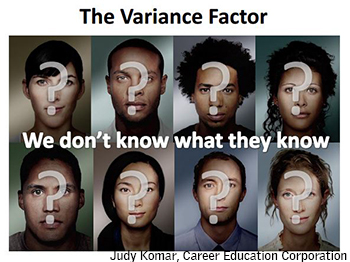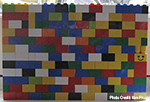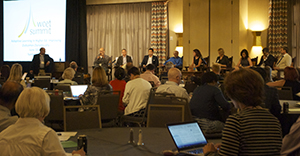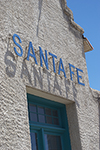As has become tradition, June 10th and 11th, a band of WCET’ers gathered to explore an emerging innovation in higher education – adaptive learning. Following in the footsteps of our summits on big data and alternative credentials, this summit looked to answer what is adaptive learning and how do we apply it in a variety of institutional settings. Today I bring you, with the help of our tweeps and the rest of the WCET team, some highlights of the summit.
Day 1
Peter Smith, chair of the WCET Executive Council and founding president, Open College @ Kaplan University, kicked us off with a few tidbits of wisdom to set the stage:
- We’re all in this circle to figure out better ways to help students learn.
- The companies participating in the Summit are here as partners, not as vendors.
- Let’s figure out how to harness it, use it & make it productive – that which makes our life difficult contains the solution. There is no silver bullet, each institution has to figure out how this works in their own context.
Opening Plenary: The Science and Promise of Adaptive Learning
Contemporary adaptive learning products and technologies are built upon a growing body of science on student engagement, content mastery, and faculty recommitment to teaching. Jim Thompson, president of CogBooks, began by sharing the three main factors he sees as creating the perfect storm for adaptive learning adoption on a greater scale:
- Explosion in demand for higher education
- Infrastructure in place to allow for high fidelity education at low cost
- The adaptive technology itself has matured
Thompson also shared how brains work – that learning occurs through structure driven by time on task with attention & motivation, repetition and sequencing. He asked us to perform a task that I’ll ask you to do now – try to quickly state the months of the year in alpha order instead of time order. Harder than you might initially think because of the way our brains store information. The key of adaptive learning is discovering what students already know, how they have structured it and what is the best path forward to them. The key to adaptive learning is personalization.
 Judy Komar, Vice President of educational technology, Career Education Corporation, followed on this same vein noting that currently, we don’t know what our students don’t know. A good way to think of adaptive learning is the swiss cheese effect – the technology allows us to identify gaps in knowledge mastery and fill those gaps that impede forward progress. If the gap remains unfilled, the challenges remain. Adaptive learning makes the students the decision makers in their learning and allows faculty to refocus on the art & science of teaching. This in turn allows them to spend less time grading and more time on interventions to move students forward. For more of the great insights shared by these experts, view the video.
Judy Komar, Vice President of educational technology, Career Education Corporation, followed on this same vein noting that currently, we don’t know what our students don’t know. A good way to think of adaptive learning is the swiss cheese effect – the technology allows us to identify gaps in knowledge mastery and fill those gaps that impede forward progress. If the gap remains unfilled, the challenges remain. Adaptive learning makes the students the decision makers in their learning and allows faculty to refocus on the art & science of teaching. This in turn allows them to spend less time grading and more time on interventions to move students forward. For more of the great insights shared by these experts, view the video.
Institutional Case Studies: Using Adaptive Learning to Improve Outcomes
In 2013, the Bill & Melinda Gates Foundation launched its Adaptive Learning Market Acceleration Program (ALMAP) which funded institutional pilots to redesign and/or create new courses in partnership with one or more adaptive learning solution providers. Rahim Rajan, senior program officer at Bill & Melinda Gates Foundation who leads the portfolio which includes the ALMAP, kicked off this panel by sharing the goals of the Foundation to improve lives gloabally, focusing in the U.S. on education. Rajan pointed to the research done by Tyton Partners (1,2), which helped add some clarity to the different ways adaptive product pioneers were creating their adaptive learning experiences. He also shared the work of John Hattie in Visual Learning that shares research based high impact pedagogical practice.
The institutions then got their opportunity to share some of the work they’ve been doing through ALMAP. Here are a few highlights from the session, but for more detail be sure to watch the video:
- Adaptive learning is a catalyst for instructors to re-engage with what they love – teaching.
- You have to think holistically about adaptive learning – it will help you get the buy-in you need.
- Students don’t know what to do with adaptive learning – they want the comfortable lecture. The key is communicating to students that you are still there for them.
- Adaptive learning does not automate the faculty out of the equation; it gives faculty more latitude to focus on the students.
- It takes a lot of academic courage to move forward with adaptive learning.
- Adaptive learning is currently a craft – higher education must move it to the industrial level for it to truly make an impact.
For more on the ALMAP program and videos of those working in the field, check out our friend Phil Hill of e-Literate and the e-Literate TV series on personalized learning.
Small Group Conversations A
These small group conversations were not recorded, however, through the diligent work of the WCET team, we can provide you with a few highlights from each session.

Adaptive Learning in Professional Education: Flipping the Lecture, Engage Students & See Results – Robert Hasel, associate dean, simulation, immersion and digital learning, College of Dental Medicine, Western University of Health Sciences.
- Motivated learners remember more.
- The “mapping” of the content is extremely important. Visualize a wall of legos. Each lego represents an explicit knowledge/competency.
- Mapping the content also allows for keeping the content current – you can update what needs to be updated in a timely manner.
Institutional Models for Developing, Supporting, and Evaluating Adaptive Learning – David Pinkus, vp for Innovation, Western Governors University
- Adaptive learning supports both the need to change previously held knowledge that is wrong and reinforce what was previously learned correctly.
- Competency-based education + adaptive learning = Optimized Learning
- Consider doing a pilot or proof of concept using micro-interventions rather than whole class reinventions.
How Adaptive Can (Has the Potential to) Increase Student Intrinsic Motivation to Persist – Kevin Bell, executive director, Curriculum Development and Deployment, College of Professional Studies, Northeastern University &
Ann Garnsey-Harter, executive director, Virtual Campus & Resource Development, Shoreline Community College
- Adaptive learning is analogous to sports, i.e. basketball – practice, immediate feedback, etc. The key difference that the basketball player WANTS to get better at basketball. How do we get someone to feel that passionate about algebra?
- A truly adaptive course can be very time consuming for faculty. But prebuilt adaptive learning courses find some faculty resistance. Either way, some faculty will resist.
- Intrinsic motivation=clear expectations, appropriate challenge, immediate and corrective feedback, sense of progress.
- Ultimately it comes down to quality teaching. The tools allow faculty to be inspirational.
The Provost’s Perspective: Why Embark on an Adaptive Strategy? Why Not? – Connie Johnson, chief academic officer and provost, Colorado Technical University
- Look at the data and give yourself permission to adjust and change in the process of implementing adaptive learning.
- It’s about the academics, not the plan. Faculty are key to implementing adaptive learning.
- It is more difficult to implement adaptive learning in subjects where students need original creativity.
Adaptive Learning Solutions: A Town Hall with Some of Industry’s Key Providers
 This two-part session began with a moderated discussion among leaders of the major companies in the adaptive learning sector, including questions and comments from summit attendees. Once the conversation concluded, attendees who had the unique opportunity to meet company CEOs, their team members, and some of their college and university partners to learn more about the products and services that support adaptive learning in higher education. While those secondary conversations were not captured, you can watch the lively panel recording. Some highlights include:
This two-part session began with a moderated discussion among leaders of the major companies in the adaptive learning sector, including questions and comments from summit attendees. Once the conversation concluded, attendees who had the unique opportunity to meet company CEOs, their team members, and some of their college and university partners to learn more about the products and services that support adaptive learning in higher education. While those secondary conversations were not captured, you can watch the lively panel recording. Some highlights include:
- Adaptive Learning is an individualized personal mastery achievement platform.
- Keep students in the zone of proximal learning. Not too easy, not too hard.
- Adaptive courseware empowers and amplifies faculty to move from a one to many relationship towards a one to one relationship
- The future of education will include open platforms, adaptive learning, and learning analytics.
- Teaching is like gardening: you can’t will the plant to grow. You create the environment that enables the plant to grow.
- We are all in a shift from education to learning, in a shift from input to output. Adaptive learning unlocks the creativity of faculty.
Small Group Conversations B
These small group conversations were not recorded, however, through the diligent work of the WCET team, we can provide you with a few highlights from each session.
Explore the Exciting Intersection of Adaptive Learning and Learning Analytics – Al Essa, vice president, Analytics and R&D, McGraw Hill Higher Education
- Analytics systems (or any learning platform or infrastructure) must provide a “safe zone” for students to practice, to fail, to learn.
- Know your audience!
- Steps for institutions: identify the need; identify the partner/vendor; collaborate on more research on adaptive, effective interventions, etc.
Adaptive Courseware Options: Before Selection, Understand Your Implementation Requirements – Dale Johnson, manager, Adaptive General Education Program, Arizona State University & Nick White, director, Competency Based Learning Solutions, Capella University
- Content curation and course configuration are big factors in the choice of adaptive learning provider. The hardest part is the ‘black box’ – is their algorithm smarter than mine?
- Content development is an art. Faculty need to have a clear-headed conversation about content development.
- Look for existing relationships – don’t be a pioneer.
- The stories matter. Get your elevator pitch. Build on early wins.
What Do Students and Faculty Say About Experiences With Adaptive Learning Courses? – Tom Cavanagh, associate vice president, Distributed Learning, University of Central Florida
- Students feel they are spending their time valuably.
- Adaptive learning implementation ROI: as students are retained at significant levels the tool pays for itself.
- Building the adaptive learning map takes time and resources.
What Does Success Look Like? What are the Key Outcome Measures to Consider when Evaluating the ROI? – Rahim Rajan, senior program officer, Postsecondary Success, Bill & Melinda Gates Foundation
- During a time of increased scrutiny and reduced resources, instiutions need to be more nimble and adept.
- Find efficient solutions to produce better outcomes.
- Consider student outcomes (equity, completion, persistence, etc)
- Consider budget factors (cost of product, course redesign, RIO, shelf life of the course material, support costs, faculty development)
- Measure faculty satisfaction
Day 2
The Devil’s in the Details: Policies, Structures, Business Models, and More
Lively even during their first cup of coffee, Tom Cavanagh, associate vice president, distributed learning, University of Central Florida led a group of dynamic experts through a guided conversation about the details that surround all aspects of adaptive learning. Experts on the panel were Diane Auer Jones, president & CEO, AJsquared Consulting; Manoj Kulkarni, CEO, RealizeIT by CCKF; David Pinkus, vice president of innovation, Western Governors University; Karen Solomon, vice president for accreditation relations, Higher Learning Commission; Nick White, director, Competency Based Learning Solutions, Capella University. These brief highlights do not do the energetic conversation justice, so don’t forget the video is available.
- Is adaptive learning really new or is it just technology-enhanced old methodology? Is it revolutionary or evolutionary?
- It’s revolutionary in how we define faculty autonomy & puts the student in the forefront of accountability. The technology is evolutionary.
- It’s revolutionary because of the scale.
- What are the myths and misconceptions about adaptive learning?
- While adapting instruction to students’ needs is not new, tech gives faculty much more information and students more agency.
- Retention is a multivariate problem not a univariate problem. Adaptive learning alone can’t fix that.
- Elephant in the room is that adaptive learning is that it’s perceived as multiple forms of the same content.
- Faculty misperception is that adaptive learning is either ‘spoon feeding’ our students or replacing faculty. It’s not human being versus machine learning.
- How do we get faculty on board?
- Faculty champions.
- Good faculty will always jump in with both feet. And hopefully they’ll drag the bad faculty, the naysayers, along with them.
- adaptivity resonates with teachers vested in student progress.
- Eliminate faculty ‘friction points’ with adaptive learning.
- There’s a communication problem because of the discussion of algorithms which seem like ‘black boxes’ and the robotization of life.
- What’s the ROI?
- Retention, retention, retention.
- Data show that adaptive learning improved outcomes for especially women & mintorities so there’s an ethical obligation to provide it as an option for our students.
- There’s also the external accountability factor adaptive learning can evidence.
- It’s all about the Delta – the change in the learning. And the accountability for external constituents & for students.
- In the absense of data, antecdote wins.
- Constructing meaningful pilots, collecting data, and getting faculty to support these initiatives = administrative support.
- How much does it cost?
- We’re in start of the adoption curve & vendors are looking for partners, for ‘wins’ so it’s cheaper now than will be.
- Start small. Fund it smartly. Build up to it as you see successes. Enterprise implementation will come later.
- It’s an upfront investment, but you may see returns over the years.
- Good onboarding is very important. It should be accessible and easily understood – like what game designers do for 1st time players.
- Final question, what’s your 140 character, pithy tweetable piece of advice?
- If you want to bring edu into this century it has to be science based diagnostic based edu.
- How will peer reviewers be able to understand the quality of the work you’re doing with adaptive learning?
- If you’re committed to strong outcomes, adaptive learning is a good commitment
- adaptive learning is active learning and the data show active learning works best.
- adaptive learning makes it possible for faculty to be the best teacher for each student
 Small Group Conversations C
Small Group Conversations C
These small group conversations were not recorded, however, through the diligent work of the WCET team, we can provide you with a few highlights from each session.
Setting a Data Foundation for Adaptive Learning: Understanding and Planning for How an Adaptive Initiative will Impact the Overall Data Ecosystem – Mike Sharkey, president, Blue Canary
- Competencies need to have a consistent set. It’s especially good if you can define competencies by career.
- How do students get their data out to resumes? LinkedIn?
- Who owns the data, who has access to the data and are there standards for the data are all outlined in the contracts with your vendors, pay attention to those.
- Plumbing alone gives you no value. It’s the things you attach to the plumbing that give you value (toilets, sinks, etc.). The same is true for the data pipeline. It’s what you do with the data that matters.
- Hear it a lot…IT DEPENDS. Need to focus on the pain point for your institution.
Leveraging Adaptive Learning within Existing Competency-Based Initiatives – Kara Van Dam, vice provost, University of Maryland University College and Ryan Hively, senior account executive, VitalSource Technologies Inc.
- Adaptive learning is a method not an algorithm, not a blackbox. It’s a sequence of learning events.
- Mind maps help look at content and overlaps, look for patterns to help organically form the adaptive paths rather than a linear trajectory. Competencies need to be looked at at the program level view, not just the course level.
- It’s important to consider what the tools can and cannot do. The adaptive learning tool is a means of serving up content, not a substitute for teaching. The tools can free good teachers to be great teachers.
Choosing an Adaptive Learning Partner (Criteria, Licenses, Open Content, and More.) – Dale Johnson, manager, Adaptive General Education Program, Arizona State University & David Pinkus, vp for Innovation, Western Governors University
- When selecting a vendor consider: gating criteria; instructional design & andragogy; instructor & administrative access; the pacing & the polish.
- Vendors should provide you with access to a sandbox to determine if their solution fits your needs.
- Create a way for students to curate their own content.
- Your slowest student is your benchmark for how much content you can include in adaptive learning courses.
- Assessment is going more & more to interactive elements. If you can solve the puzzle, you’ve mastered the content.
- Overheard in #wcetsummit session – I don’t understand gaming, but I understand the look on my granddaughter’s face when she plays.
Post WCET Summit: What Are Your Next Steps? What More Do You Need to Know? – Judy Komar, vice president of educational technology, Career Education Corporation
- If you have knowledge gaps, you can use adaptive learning anywhere in academia –> undergrad and beyond.
- Adaptive learning is not always faster. Acceleration is the glam & glitz of marketing, still have to help students persist.
- Pilot not just to determine if we use adaptive learning or not. Pilot means calibrate! Calibrate the faculty, system, and curriculum!
- An integrated model to adaptive learning should identify programs/courses that will improve student success overall.
- Always go back to looking at YOUR institution, your goals, your students. It will be different depending on your situation.
Adaptive Learning is Ready as an Applied Innovation – Are You Ready?
Mike Abbiatti and Peter Smith led us on a guided discussion for the last session of the day to answer 3 final questions – what are the characteristics of successful adaptive learning? Does adaptive learning work? And what 5 things do you need to have for deployment? You can see the more candid version in the video but here are the crowdsourced answers from the closing session.
The top 10 characteristics of successful adaptive learning are:
- Efficiency of getting to objectives. Still the same ultimate goals, AL is just a method to integrate with the current teaching and learning methodology.
- Individualized/personalized.
- Scalable.
- Clarity– data and elements within the system and sharing of data.
- Cost effective.
- Responsive design.
- Basic ed-critical thinking
- Measurable outcomes
- Motivating- students and faculty
- Promoting student success.
Does Adaptive Learning Work?
- Yes, across the student profile and faculty (medical/dental). “Game changer”
- Yes, faculty have more time for higher level thinking and at the student level (gen ed. Freshman)
- Yes, i.e. Abe Lincoln
- Yes, data informs decision making (corp perspective)
- Yes, but important to look at the theory and the implementation.
- Yes, analytics help faculty and students.
- Yes, statistically it helps marginalized students.
- Yes, but…cost of entry and ROI.
What 5 Things Do You Need to Have for Deployment?
- Effective Faculty Development.
- Senior leadership buy-in.
- Leadership that is not afraid of risk.
- Faculty champions.
- Resources/$$$.
 We all left Santa Fe invigorated at the future possibilities that adaptive learning holds for higher education. Resources from the summit are available on our website and WCET has made a commitment to continuing this conversation at our 27th Annual Meeting in Denver November 11-13, as well as through our blogs, social media, members-only discussion list and research. We welcome those who were there to add anything we missed and those who weren’t able to make it to Santa Fe to join in the continued conversation.
We all left Santa Fe invigorated at the future possibilities that adaptive learning holds for higher education. Resources from the summit are available on our website and WCET has made a commitment to continuing this conversation at our 27th Annual Meeting in Denver November 11-13, as well as through our blogs, social media, members-only discussion list and research. We welcome those who were there to add anything we missed and those who weren’t able to make it to Santa Fe to join in the continued conversation.

Cali Morrison
Communications Manager, WCET
Follow us on Twitter: WCET|Personal
Photo Credit: Test: Lego Wall by Kim Phu
Santa Fe Photos by: Cali Morrison
 Judy Komar, Vice President of educational technology, Career Education Corporation, followed on this same vein noting that currently, we don’t know what our students don’t know. A good way to think of adaptive learning is the swiss cheese effect – the technology allows us to identify gaps in knowledge mastery and fill those gaps that impede forward progress. If the gap remains unfilled, the challenges remain. Adaptive learning makes the students the decision makers in their learning and allows faculty to refocus on the art & science of teaching. This in turn allows them to spend less time grading and more time on interventions to move students forward. For more of the great insights shared by these experts, view the video.
Judy Komar, Vice President of educational technology, Career Education Corporation, followed on this same vein noting that currently, we don’t know what our students don’t know. A good way to think of adaptive learning is the swiss cheese effect – the technology allows us to identify gaps in knowledge mastery and fill those gaps that impede forward progress. If the gap remains unfilled, the challenges remain. Adaptive learning makes the students the decision makers in their learning and allows faculty to refocus on the art & science of teaching. This in turn allows them to spend less time grading and more time on interventions to move students forward. For more of the great insights shared by these experts, view the video. This two-part session began with a moderated discussion among leaders of the major companies in the adaptive learning sector, including questions and comments from summit attendees. Once the conversation concluded, attendees who had the unique opportunity to meet company CEOs, their team members, and some of their college and university partners to learn more about the products and services that support adaptive learning in higher education. While those secondary conversations were not captured, you can watch the lively panel recording. Some highlights include:
This two-part session began with a moderated discussion among leaders of the major companies in the adaptive learning sector, including questions and comments from summit attendees. Once the conversation concluded, attendees who had the unique opportunity to meet company CEOs, their team members, and some of their college and university partners to learn more about the products and services that support adaptive learning in higher education. While those secondary conversations were not captured, you can watch the lively panel recording. Some highlights include: We all left Santa Fe invigorated at the future possibilities that adaptive learning holds for higher education. Resources from the summit are available on our website and WCET has made a commitment to continuing this conversation at our 27th Annual Meeting in Denver November 11-13, as well as through our blogs, social media, members-only discussion list and research. We welcome those who were there to add anything we missed and those who weren’t able to make it to Santa Fe to join in the continued conversation.
We all left Santa Fe invigorated at the future possibilities that adaptive learning holds for higher education. Resources from the summit are available on our website and WCET has made a commitment to continuing this conversation at our 27th Annual Meeting in Denver November 11-13, as well as through our blogs, social media, members-only discussion list and research. We welcome those who were there to add anything we missed and those who weren’t able to make it to Santa Fe to join in the continued conversation.